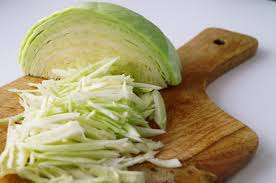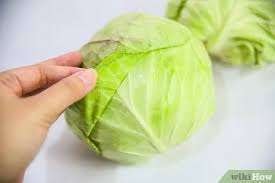Find out how long does cabbage last in the fridge. Are you storing it properly and what needs to happen before you should toss it from your home’s cold storage.
How long does cabbage last in the fridge?
Cabbage is a vegetable that can last 3-4 weeks when stored in the fridge. It is best to store it in perforated plastic bags with all of the air squeezed out, or in quart sized freezer bags with one corner cut off. Cabbage will also keep up to two months if stored in a cool basement.
Cabbage has many health benefits and can be eaten raw or cooked. For example, cabbage contains vitamin C which helps keep your skin healthy by boosting collagen production.

Cabbage is a vegetable that can be stored in the fridge for up to 10 days. If you want to extend its life, consider storing it in a container with water and ice cubes. You could also add some vinegar or salt to preserve it for longer periods of time.
Cabbage is a nutrient rich vegetable that can be enjoyed cooked or raw. If you have some cabbage leftover from last week’s dinner, you may be wondering how long it will stay fresh in the fridge. Cabbage is a versatile vegetable that can be used in many dishes.
How do you know when cabbage goes bad?
Cabbage is a vegetable that can last up to three weeks in the fridge, but there are some telltale signs that it’s gone bad. The first noticeable sign of spoilage is if the leaves start to turn brown or black near the edges. Another indication of spoilage is an off odor, like moldy cheese. Finally, if you pull out a leaf and it feels slimy or slippery instead of crisp and firm, it’s time for trash day.
Cabbage is a vegetable that can last up to 6 months if stored correctly. When you purchase cabbage, look for heads that are firm with tightly packed leaves and avoid any heads with slimy spots or wilted leaves. If the cabbage has been in your fridge for more than 4 days, it’s time to toss it out. The best way to tell if your cabbage is bad is by smelling it. A strong rotten odor means its time to throw away.

Cabbage is a vegetable that can last up to 6 months if stored correctly. When you purchase cabbage, look for heads that are firm with tightly packed leaves. It’s also a great source of vitamin C, dietary fiber, and other beneficial nutrients.
After using the whole head of cabbage, trim off any leftover leaves and place it in a sealed plastic bag or container. Place the container in your refrigerator’s crisper for up to one week. This will allow the cabbage time to rest so that it can be eaten without any side effects.
How do you keep cabbage fresh in the fridge?
Cabbage is a vegetable that can be stored in the fridge for days if you know how to keep it fresh. Cabbage is best kept on the bottom shelf of your refrigerator, and should be wrapped tightly with plastic wrap or aluminum foil to maintain its crispness. The cabbage will stay fresher longer this way because air cannot reach it as easily as when it’s left out in an open container.
The cabbage is a vegetable that can be stored in the refrigerator for up to six weeks. To keep it fresh, wrap the head of cabbage with plastic wrap and place it in a plastic bag before storing. The wrapping prevents moisture from escaping and keeps its nutrients intact. It should not be left out on countertops where bacteria will have access to it or put into crisper drawers because this may cause premature spoilage.
Can you get sick from eating old cabbage?
Cabbage is a staple in many dishes. It’s also tasty on its own, but is it possible to get sick by eating old cabbage? According to the USDA, there are no known cases of food borne illness specifically caused by consuming old or spoiled cabbage.

The Centers for Disease Control and Prevention (CDC) states that most food-borne illnesses are due to improper handling of foods after they have been cooked. For example, if you put raw meat on top of cooked vegetables without washing your hands first, then touch other foods like bread with those same dirty fingers before touching the bread again you may leave harmful bacteria behind on the surface of this food. So while eating fresh cabbage doesn’t seem dangerous, be sure not to contaminate other foods.
The smell of cabbage can be overwhelming, but it takes a lot more than just smelling the odor to actually get sick from eating old cabbage. Cabbage is hardy and has a long shelf life if stored properly. The taste of rotten cabbage will make you feel sick before any bacteria or germs are able to take hold.
The only way for food poisoning to occur is if the meat inside the cabbage was not cooked at all or enough, which would allow harmful organisms to flourish in the environment between when you first prepare your meal and when you eat it later down the road. So as long as that does not happen then there should be no worries about getting sick from eating old cabbage.
How do I store my 6 month old cabbage?
It can be tricky to know how to store vegetables properly. It’s harvest time and you have a bounty of fresh produce waiting to be preserved. But what do you do with that head of cabbage that’s been staring at you for the last six months?
You may be wondering what to do with it now that it has gone bad. The good news is, there are plenty of ways to store your cabbage if you don’t want to just throw it away. There are two main options: you can either freeze the whole head or shred and freeze the cabbage separately. And if neither of those work for you, then you can compost or dispose of your old cabbage as well.
When should I store my cabbage?
If storing in the freezer, place it in the freezer immediately after purchase and use it within two months. If storing shredded, place shredded pieces on a tray lined with parchment paper and freeze before transferring into an airtight container or bag for long term.

If you have a cabbage in your fridge, but you’re not sure how to store it for the next six months. You should either wash and dry the cabbage or chop up the cabbage and put it into an airtight container. If you’re unsure about whether or not your cabbage is still fresh enough to eat, take a look at its color.
If it looks greenish brown then there’s still life left in that head of yours. However if the color has become more yellow than anything else then it might be time for a trip over to the compost pile or maybe even a visit from some hungry worms? It all depends on preference really.
Read More:

